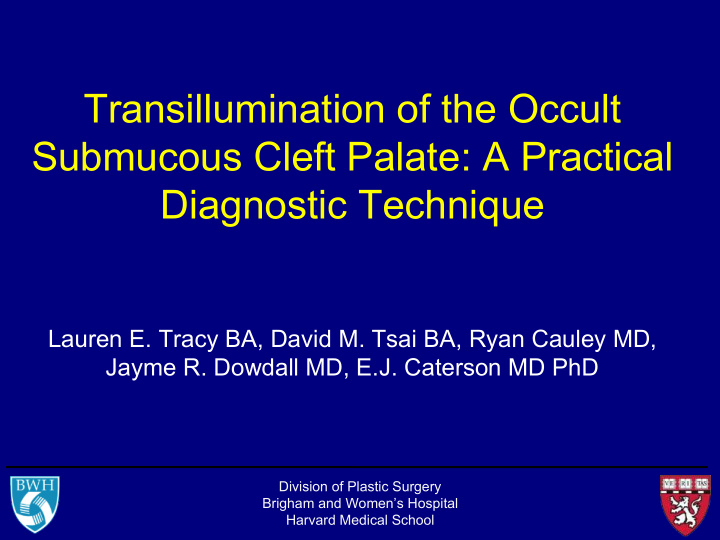



Transillumination of the Occult Submucous Cleft Palate: A Practical Diagnostic Technique Lauren E. Tracy BA, David M. Tsai BA, Ryan Cauley MD, Jayme R. Dowdall MD, E.J. Caterson MD PhD Division of Plastic Surgery Brigham and Women’s Hospital Harvard Medical School
Disclosures • The authors have no financial disclosures, or conflicts of interest to disclose. Division of Plastic Surgery Brigham and Women’s Hospital Harvard Medical School
Submucous Cleft Palate Congenital defect with deficient union of the muscles that normally cross the velum and aid in soft palate elevation
Submucous Cleft Palate • Overt submucous cleft palate has obvious external anatomic landmarks, and an estimated prevalence of 0.02% to 0.08%. • Occult submucous cleft palate prevalence is difficult to estimate as patients lack external anatomic deficits. • Studies suggest occult submucous cleft palate may be far more prevalent than currently recognized. Division of Plastic Surgery Brigham and Women’s Hospital Harvard Medical School
Need for Pre-operative Diagnosis • Oropharyngeal surgery on patients with undiagnosed submucous cleft palate can result in iatrogenic velopharyngeal insufficiency (VPI). • VPI causes hypernasal speech, air emission, nasal regurgitation and difficulty swallowing. • 5-50 % of patients with submucous cleft palate have VPI at baseline. Division of Plastic Surgery Brigham and Women’s Hospital Harvard Medical School
Need for Pre-operative Diagnosis • The absence of external anatomic markers makes the diagnosis of occult submucous cleft difficult, and dependent on ancillary tests.
Current Diagnostic Methods Cannot Detect Cannot Detect Requires Abnormal Abnormal Expensive Multiple Anatomy Movement Visits X Physical Exam X X X MRI X X X Fluoroscopy X Nasoendoscopy X Ultrasound
Transillumination Technique • Flexible fiberoptic flexible fiberoptic laryngoscope laryngoscopy is already commonly used in peri- operative workup of craniofacial surgery patients. • Scope is introduced through patient’s nose or mouth, then angled anteriorly to transilluminate the velum.
Transillumination Benefits flexible fiberoptic laryngoscope • Employs tools already routinely used by craniofacial surgeons. • Easily integrated into practice. • Inexpensive • Quick
Transillumination Results P atient with occult Normal patient submucous cleft palate
Transillumination Findings Normal patient • Homogenous velum, with no anterior lucency. • Transilluminated velar musculature continues to midline. • No notching of hard palate.
Transillumination Findings P atient with occult submucous cleft palate • Pronounced central and anterior lucency. • Deficient median interdigitation of velar musculature. • Notching of hard palate.
Conclusions Transillumination is an inexpensive, quick, and easily incorporated technique to screen for undiagnosed occult submucous cleft palate.
Selected References 1. Calnan, J. Submucous cleft palate. Br. J. Plast. Surg. 6, 264–82 (1954). 2. Weatherley-White, R. C., Sakura, C. Y., Brenner, L. D., Stewart, J. M. & Ott, J. E. Submucous cleft palate. Its incidence, natural history, and indications for treatment. Plast. Reconstr. Surg. 49, 297–304 (1972). 3. García Velasco, M., Ysunza, A., Hernandez, X. & Marquez, C. Diagnosis and treatment of submucous cleft palate: a review of 108 cases. Cleft Palate J. 25, 171–3 (1988). 4. Shprintzen, R. J., Schwartz, R. H., Daniller, A. & Hoch, L. Morphologic significance of bifid uvula. Pediatrics 75, 553–61 (1985). 5. Abdel-Aziz, M. Treatment of submucous cleft palate by pharyngeal flap as a primary procedure. Int. J. Pediatr. Otorhinolaryngol. 71, 1093–7 (2007). 6. Nasser, M., Fedorowicz, Z., Newton, J. T. & Nouri, M. Interventions for the management of submucous cleft palate. Cochrane database Syst. Rev (2008). 7. Saunders, N. C., Hartley, B. E. J., Sell, D. & Sommerlad, B. Velopharyngeal insufficiency following adenoidectomy. Clin. Otolaryngol. Allied Sci. 29, 686– 8 (2004). Division of Plastic Surgery Brigham and Women’s Hospital Harvard Medical School
Recommend
More recommend